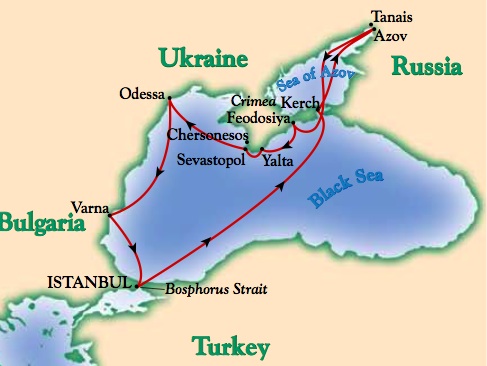Sea of Azov
THE SEA OF AZOV is an arm of the BLACK SEA, extending from the mouth of the River Don to the Kerch Strait. It covers 14,520 square mi (37,230 square km) and is 226 mi (365 km) east to west, and 110 mi (175 km) north to south. RUSSIA borders the sea to the east, with UKRAINE to the north and the Crimean Peninsula to the west and south. The sea has an average depth of only 26 ft (8 m), making it the shallowest sea in the world. The northeast portion narrows to form the Gulf of Taganrog (also known as the Gulf of Azov), which is an extension of the Don estuary. Here, the average depth is less than 3.3 ft (1 m), requiring constant dredging of channels for deep-sea vessels. The other major river that flows into the Azov is the Kuban, which runs from the North Caucasus mountains to the east. The Don and Kuban rivers bring in large amounts of fresh water, resulting in the sea's low salinity levels. In winter, much of the sea is covered in ice.

Because of its mixture of fresh and saline waters, the Sea of Azov has the second-largest fishing industry in Russia, though this has suffered in recent decades from over-fishing and pollution. The Azov is also important as a transportation corridor for coal and iron ore extracted from the nearby Donets basin, in eastern Ukraine, and for river traffic from Russia's vast interior, traveling via the VOLGA-Don Canal. The Manych Canal also links directly to the CASPIAN SEA and its reserves of oil and natural gas. Salt is extracted in large quantities from the area known as the Syvash (or “putrid”) Sea, a backwater along the Crimean Peninsula (the northwest coast of the Sea of Azov) that derives its name from the area's unhealthful odor of decaying vegetation. The Arabat Peninsula separates the Syvash from the main Azov waters: a narrow strip of mud and sand, varying from 3,000 ft to 2.5 miles (1 to 4 km) in width, stretching for 70 mi (113 km). The Genichesk Strait connects the two bodies of water but is occasionally silted over.
The settlements surrounding the Sea of Azov were always important centers of trade between the Mediterranean world and the Eurasian interior. The Greek city of Tanais, established in the 7th century B.C.E., went through several incarnations—including a Genoese colony in the 13th century (Tana)—before becoming the Ottoman outpost of Azov. Russian desires to establish a warm-water fleet led to several campaigns against the Turks, but the city was not definitively taken until 1774. Today, several other major port cities surround the Sea of Azov, including Rostov and Taganrog (Tahanrih) at the mouth of the Don, Berdyansk and Mariiupil on the northern shore, and Kerch at the narrow point between the Sea of Azov and the Black Sea.